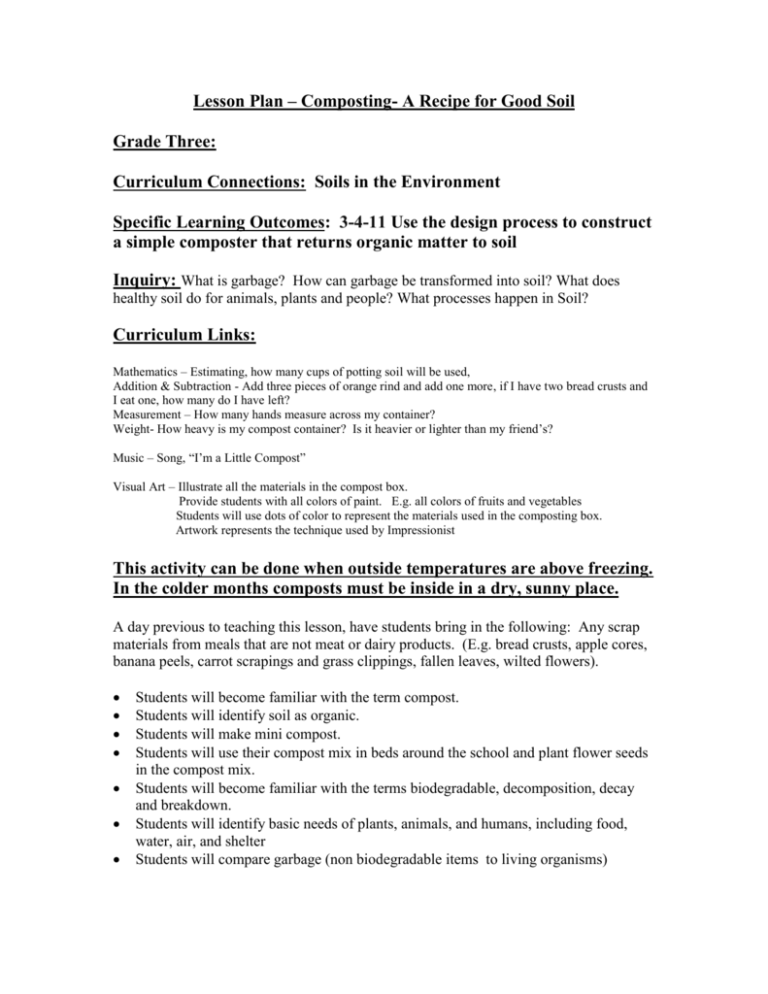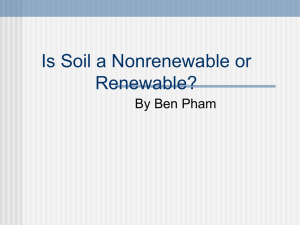Lesson Plan – Composting- A Recipe For Good Soil
advertisement

Lesson Plan – Composting- A Recipe for Good Soil Grade Three: Curriculum Connections: Soils in the Environment Specific Learning Outcomes: 3-4-11 Use the design process to construct a simple composter that returns organic matter to soil Inquiry: What is garbage? How can garbage be transformed into soil? What does healthy soil do for animals, plants and people? What processes happen in Soil? Curriculum Links: Mathematics – Estimating, how many cups of potting soil will be used, Addition & Subtraction - Add three pieces of orange rind and add one more, if I have two bread crusts and I eat one, how many do I have left? Measurement – How many hands measure across my container? Weight- How heavy is my compost container? Is it heavier or lighter than my friend’s? Music – Song, “I’m a Little Compost” Visual Art – Illustrate all the materials in the compost box. Provide students with all colors of paint. E.g. all colors of fruits and vegetables Students will use dots of color to represent the materials used in the composting box. Artwork represents the technique used by Impressionist This activity can be done when outside temperatures are above freezing. In the colder months composts must be inside in a dry, sunny place. A day previous to teaching this lesson, have students bring in the following: Any scrap materials from meals that are not meat or dairy products. (E.g. bread crusts, apple cores, banana peels, carrot scrapings and grass clippings, fallen leaves, wilted flowers). Students will become familiar with the term compost. Students will identify soil as organic. Students will make mini compost. Students will use their compost mix in beds around the school and plant flower seeds in the compost mix. Students will become familiar with the terms biodegradable, decomposition, decay and breakdown. Students will identify basic needs of plants, animals, and humans, including food, water, air, and shelter Students will compare garbage (non biodegradable items to living organisms) Materials Needed: Large flower pot or plastic container Spoons Small spray bottle Potting soil Pop can tab Small plastic bag Fast food container Small plastic container Packages of seeds Activity: Read the story, Composting: Growing gardens From Your Garbage, by Linda Glaser Brainstorm with the class the term compost. List student ideas. Explain that composting is the process of transforming garbage into decaying matter, then recycling it back to its natural state. (soil) Have students fill a large plant pot or plastic container 1/3 full of soil. Have students layer refuse items brought from home on top of the soil. Add more soil, and then add water until mixture is moist. Every few days, have students repeat the layering process making sure you have some soil on top of the mixed layer. You can add non-biodegradable items (i.e. pop can tab, plastic lid) to demonstrate how non-organic items will not decompose (break down) and are considered waste Discuss the difference between biodegradable and non-biodegradable items. Have students hypothesize which items in their everyday lives are biodegradable and non-biodegradable. List on chart paper. Place compost pots in a sunny area outside. (They will smell). Explain that the pots will start to smell because the decomposing material contains bacteria that break down the organic matter/items. Heat will help the chemical processes to start. Explain the role of animals in the soil (fungi/protozoa’s) and how other animals such as earthworms, centipedes, millipedes and beetles assist the bacteria in the decomposing process. Discuss how soil and compost materials provide food and homes for many animals. List different types of animals that live in the soil eco-system. Have the class learn the song,” “I’m A Little Compost” Performed to the tune, “I’m A Little Teapot” I’m a little compost short and fat Here are my bread crusts; here are my peels When I get all mixed up, dump more in Watch me heat and let me rot Have students observe and record changes in the mixture Have students identify components of the soil (i.e. colour, texture, odor) Extension: Students use their compost mixture in flowerbeds around the school. Students can compare the success of flowerbeds (flower beds with compost, flowerbeds did not receive compost mixture) Art – Gummie worm prints: Take a light brown piece of paper, cover with a light layer of white glue. Have students use their finger to make tunnels in the glue. Sprinkle coffee grinds all over the top of white glue. Let dry. Have students dip or roll gummie worms in paint. Drop the paint covered gummie worm inside the tunnels on brown paper and press. A print of the gummie worm should appear showing the line segments of the worm. Students can use red, brown or purple for the worms. Art - Recycling Follow up questions: Why is composting important to our environment and to our community? What does composting do for the soil? (Supplies more nutrients) How does composting affect other living organisms? Bake brownies for a classroom treat! One 9 by 13 (22cm. by 33.5cm.) bakes for 25 students. If class size is larger cut brownies smaller. Recipe to follow. Brownies - A rich recipe that looks like humus. Ingredients 1 cup of melted butter or margarine 2 cups packed brown sugar 2 eggs 3 tsp. vanilla 4 great big tbsp. of cocoa 1 cup of flour (250 ml.) (500 ml.) (15 ml.) (60 ml.) (250 ml.) Stir it all up with a wooden spoon and pour into a greased 9-by13 pan. (22cm. by 33.5cm) For variations add raisins or chocolate chips or icing. Bake at 350 for 25 minutes.






